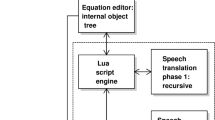Abstract
Although Digital Accessible Information System, an international digital talking book standard, is conducting active research on upper level education for people with reading disabilities, special components like images or formulas are difficult to read aloud in Korean. Therefore, this paper defines Korean math-to-speech rules for Contents Mathematical Markup Language based on the formulas used in the Korean middle school and high school freshman curriculum. Based on the proposed rules, a program that turns formulas expressed in Contents Mathematical Markup Language into speech was also designed through Extensible Stylesheet Language Transformations. Finally, a performance test was conducted to determine both the accuracy of the transformed formulas and the clarity of formulas when read aloud.











Similar content being viewed by others
References
Lee KH, Lee TE, Lee JW, Lim SB (2013) A design of mobile e-book viewer interface for the reading disabled people. J Korea Multimed Soc 16(1):100–107
Park JH, Lee KH, Lee JW, Lim SB (2015) Design of voice annotation system to enhance the quality of life for visually-impaired readers. Asian Int J Life Sc, ASIA LIFE SCI Suppl 11:109–121
Seo SH, Lee JW, Lim SB (2012) A reading technique of math expression in e-book for reading-disabled people. J HCI Soc Korea 7(2):57–64
W3C, Mathematical Markup Language (MathML) Version 3.0 2nd Edition, 2014
W3C, XSLT Specification, Available: https://www.w3.org/TR/xslt Accessed 30 March 2018
DAISY Consortium (2005) Specifications for the Digital Talking Book, ANSI/NISO Z39.86–2005
Neil Soiffer (2015) Browser-independent accessible math, in Proceeding of W4A 2015, Article No. 28
gh-MathSpeak. MathSpeak Core Specification Grammar rules, Available: http://www.gh-mathspeak.com/examples/grammar-rules/ Accessed 15 March 2018
MathGenie, MathGenie, Available: http://www.mathgenie.com/ Accessed 15 March 2018
Wiris, MathType, Available: http://www.wiris.com/mathtype Accessed 25 May 2020
Davide C, Peter K, Volke S (2016) New accessibility features. J Technol Persons Disabil 4:167–175
Dumkasem K, Srisingchai P, Rattanatamrong P (2019) EyeMath: Increasing Accessibility of Mathematics to Visually Impaired Readers, In: Proceeding of 2019 23rd International Computer Science and Engineering Conference (ICSEC), pp. 197–202
Kacorri H, Riga P, Kouroupetroglou G (2014) EAR-Math: Evaluation of Audio Rendered Mathematics, In: Proceeding of UAHCI 2014: Universal Access in Human-Computer Interaction. Universal Access to Information and Knowledge, pp. 111–120
Fitzpatrick D (1999) Towards Accessible Technical Documents: Production of Speech and Braille Output from Formatted Documents. Doctoral dissertation, Dublin City University
Yamaguchi K, Suzuki M (2010) On necessity of a new method to read out math contents properly in DAISY, In Proceeding of International Conference on Computers for Handicapped Persons 2010(ICCHP), 415–422
Wongkia W, Naruedomkul K, Cercone N (2009) Better Access to Math for Visually Impaired, In Proceeding of 2009 IEEE Toronto International Conference Science and Technology for Humanity , 43–48
Salamonczyk A, Brzostek-Pawlowska J (2015) Translation of MathML formulas to Polish text, example applications in teaching the blind in Proceeding of IEEE 2nd International Conference on Cybernetics (CYBCONF), 240–244
W3C, SSML Specification, Available: http://www.w3.org/TR/speech-synthesis/ (accessed March, 15, 2018)
Tullis T, Alvert B (2009) Measuring user experience. Elsevier, Amsterdam
Acknowledgements
This research was supported by Basic Science Research Program through the National Research Foundation of Korea (NRF) funded by the Ministry of Education (NRF-2018R1A4A1025559).
Author information
Authors and Affiliations
Corresponding author
Additional information
Publisher’s Note
Springer Nature remains neutral with regard to jurisdictional claims in published maps and institutional affiliations.
Rights and permissions
About this article
Cite this article
Park, J.H., Lee, JW., Um, JS. et al. Korean language math-to-speech rules for digital books for people with reading disabilities and their usability evaluation. J Supercomput 77, 6381–6407 (2021). https://doi.org/10.1007/s11227-020-03519-0
Accepted:
Published:
Issue Date:
DOI: https://doi.org/10.1007/s11227-020-03519-0




